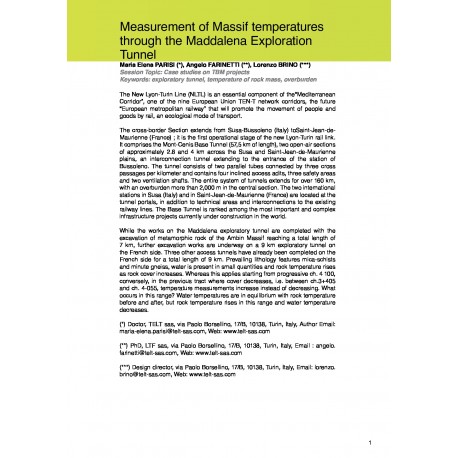Cart
0
0
No document
0,00 €
Total
Document successfully added to your shopping cart
Quantity
Total
There are 0 items in your cart.
There is 1 item in your cart.
Total documents
Total shipping
To be determined
Total
Search & filter
Search for a publication
Search & filter
Measurement of Massif temperatures through the Maddalena Exploration Tunnel
2695_measurement_of_massif_tempe
M. E. Parisi / A. Farinetti / L. Brino
The New Lyon-Turin Line (NLTL) is an essential component of the“Mediterranean Corridor”, one of the nine European Union TEN-T network corridors, the future “European metropolitan railway” that will promote the movement of people and goods by rail, an ecological mode of transport. The cross-border Section extends from Susa-Bussoleno (Italy) toSaint-Jean-de-Maurienne (France) ; it is the frst operational stage of the new Lyon-Turin rail link. It comprises the Mont-Cenis Base Tunnel (57,5 km of length), two open-air sections of approximately 2.8 and 4 km across the Susa and Saint-Jean-de-Maurienne plains, an interconnection tunnel extending to the entrance of the station of Bussoleno. The tunnel consists of two parallel tubes connected by three cross passages per kilometer and contains four inclined access adits, three safety areas and two ventilation shafts. The entire system of tunnels extends for over 160 km, with an overburden more than 2,000 m in the central section. The two international stations in Susa (Italy) and in Saint-Jean-de-Maurienne (France) are located at the tunnel portals, in addition to technical areas and interconnections to the existing railway lines. The Base Tunnel is ranked among the most important and complex infrastructure projects currently under construction in the world. While the works on the Maddalena exploratory tunnel are completed with the excavation of metamorphic rock of the Ambin Massif reaching a total length of 7 km, further excavation works are underway on a 9 km exploratory tunnel on the French side. Three other access tunnels have already been completed on the French side for a total length of 9 km. Prevailing lithology features mica-schists and minute gneiss, water is present in small quantities and rock temperature rises as rock cover increases. Whereas this applies starting from progressive ch. 4 100, conversely, in the previous tract where cover decreases, i.e. between ch.3+405 and ch. 4-055, temperature measurements increase instead of decreasing. What occurs in this range? Water temperatures are in equilibrium with rock temperature before and after, but rock temperature rises in this range and water temperature decreases.




